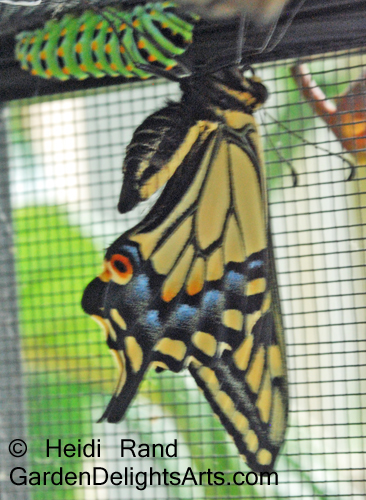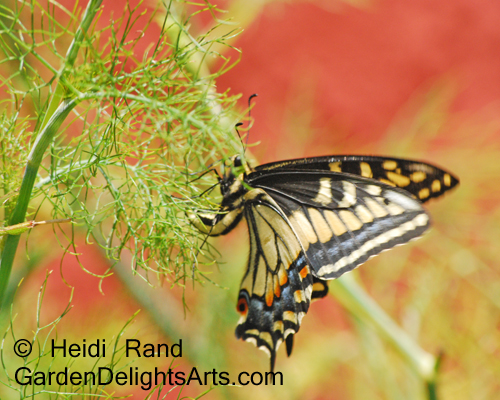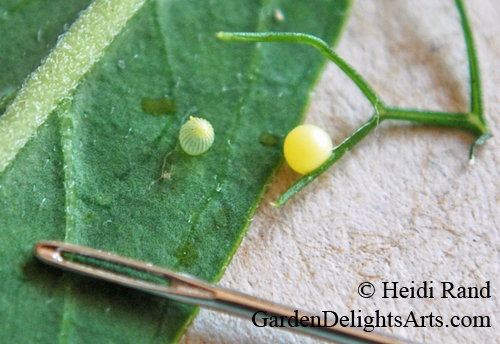We’re still finding anise swallowtail butterfly eggs on the fennel in our garden. And ta .. daaa… the first of the recent batch we’re raising emerged today. Born on the Fourth of July; more orange, yellow and blue than red, white and blue, and with stripes!

The caterpillar at the top of the enclosure looks like it’s ready to form its chrysalis. And here are younger sibling caterpillars, still eating away.

We’ve been gathering fennel around the neighborhood, because our plants are starting to be pretty sparse after feeding at least 30 growing caterpillars!
So which do you think came first, the butterfly or the egg? I don’t have an answer to that old conundrum, but to bring the story full cycle, I just took this photo of one of the anise swallowtails depositing eggs on the fennel in our garden.

Since we’re also finding monarch butterfly eggs on our milkweed, I took an extreme closeup photo of a monarch butterfly egg (on the left) and an anise swallowtail egg (on the right), to compare their sizes, and with the head of a needle included for scale.

Click here to see my post about the monarch butterfly that left that egg.
I’ve said it before, and I’ll say it again – if you have to cut down the fennel that’s growing on your property, please check it carefully for eggs, caterpillars, and chrysalises first. You could be killing an entire generation of anise swallowtail butterflies.
Loved the story about your bees and the swallowtails were just lovely. I am raising Monarch, Zebra Longwings and Swallowtails. I was wondering how much knowledge you had about butterflies. The monarchs seem to keep dying in the chrysalis.
Bridget, My husband knows a lot about raising butterflies, and we learn more as we do it. We do lose some of them for various reasons; since we find many more anise swallowtails we have comparably more of them die. We’ve had problems with monarchs that we found in very cold weather. I’ll ask him if he has ideas about your monarchs dying.
Thanks, Heidi
I live in Orlando, Florida and a friend near by has lost several of them too. thanks for any information in advance.
Bridget, George had a couple of thoughts — it may be a parasite called OE (although I looked at some sites about that and I’m not sure), he also wondered whether there was too much moisture in the environment where they are. Neither of these may be the problem, sorry we can’t come up with other ideas! I hope some of them are okay anyway.
Heidi
Heidi –This is so wonderful. I forgot that fennel grows wild in CA. Thank you for suggesting that people search for caterpillars before they cut. I’ve planted a big patch of milkweed in my garden, and am checking every day now for the telltale nibblings of the Monarch larvae.
Lauren — Great to hear that you planted the milkweed — and it’s one of the few plants that chickens won’t munch on. We have 3 monarch chrysalises incubating right now, eagerly awaiting their emergence!